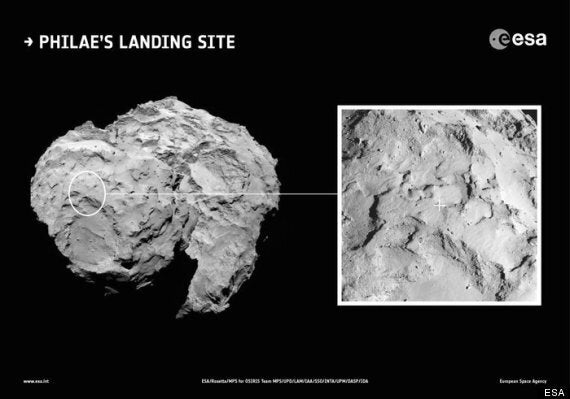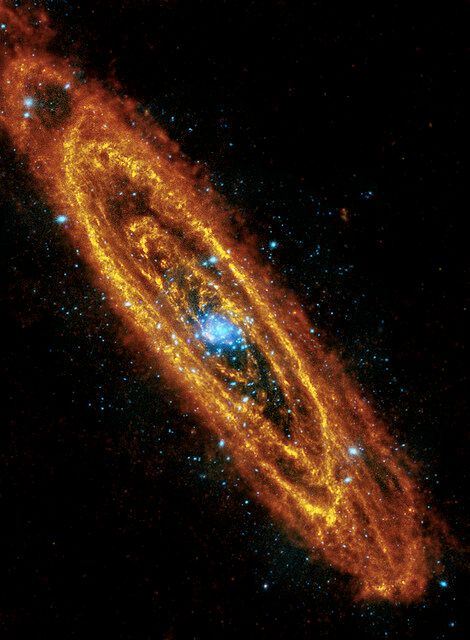
After 10 years travelling towards its destination, looping around the sun five times, and logging up 6.4 billion kilometres -- Rosetta has arrived for the drop of a lifetime.
Discovery’s "Landing On A Comet: Rosetta Mission" joins this pioneering space mission led by the European Space Agency -- which has set out to eject Philae, a lander, onto the surface of Comet 67P/Churyumov-Gerasimenko. Premiering on the same day as the scheduled landing (Wednesday, November 12 at 7 p.m. ET), and anchored by "Daily Planet" co-host Dr. Dan Riskin from Germany, the one-hour special chronicles how the futuristic science lab will unleash powerful anchors to hold on to this comet.
Why catch a comet? Once Philae lands, it will embark on the most incredible journey to gather and analyze what is considered a yet-unreachable primordial treasure chest. But a successful landing is far from guaranteed. Scientists compare landing Philae on the comet to trying to drop a piece of paper from a Boeing 747 at cruising altitude over New York City and trying to hit Central Park.
HuffPost Canada TV spoke with Riskin about the special before he headed off to Germany, and we got the dirt on the mission.
HuffPost Canada TV: So we’re landing something on a comet. How in the hell is that even possible?
Dan Riskin: Simple. I don’t know what the big deal is. You launch a rocket on a trajectory that has it loop around Earth four times, then go around Mars, then go to sleep for two-and-a-half years, and then travel out further from Earth than any other solar-powered spacecraft has ever gone before, then have it wake itself up, and then have it chase down the comet -- which until now has just looked like a far-away space blob, but turns out it's like a giant spinning four-kilometre-long rubber duckie going 137,000 kph with gasses coming out of it.
Then the spacecraft finds a safe orbit around the duck, takes photos of the surface so that the people back on Earth can choose a landing spot, and then from 22.5 km up, it throws a lander out, with no thrusters on it or anything that would control its descent. Simple. Then we all just watch it fall for seven hours until it lands. We don’t know if it’s landing in powder or on a sandy hill, or on sheer ice, but once it lands it'll screw itself into the ground and secure itself with harpoons. And then so long as it didn't accidentally fall on its side, it does some drilling/photographing/sampling and we get to see a side of the early solar system that we've never seen before. Ten years from launch to landing. So really it’s no big deal.

(Site J is on the head of Comet 67P/Churyumov–Gerasimenko. An inset showing a close-up of the landing site is also shown. The inset image was taken by Rosetta’s OSIRIS narrow-angle camera on August, 20 2014 from a distance of about 67 kilometres (42 miles). The background image was taken on August 16 from a distance of about 100 kilometres. The image scale is 1.2 metres/pixel.)
What are the biggest challenges we’re facing with this mission?
Catching the comet and getting into orbit around it is the most impressive feat, and that’s already happened! To travel 6.7 billion kilometres to catch a 4-kilometre-long object is like travelling across the 5,000 kilometres of Canada to find something the size of a beak on the loon on a loonie (3 millimetres or so). There’s a reason people make a big deal about how hard rocket science is. That was a ten-year journey. The human brain can’t even imagine a distance like that.
How does one "cover" this kind of thing?
To do it properly, Discovery needed to put me in a rocket 10 years ago to send me along. That didn’t happen, so we’re doing the next best thing: I’ll be at ESA mission control in Darmstadt, Germany, for the whole process -- starting with the ejection of the Philae lander from the Rosetta spacecraft, the seven hours of waiting for it to land, then the touchdown itself, and the flurry of science that will happen immediately after landing. If landing is successful, they have no way of knowing how long Philae will last. The ground beneath it could crumble at any moment, or a vent could spring up, so they’ll be working as fast as you can imagine after landing to get some data. We’ll be there for all of that.
What’s the ultimate scientific outcome that scientists are hoping to gain from this mission?
We want to know what the proto-materials were that built our Earth and that built life on Earth. This comet is a time capsule from the early solar system that lets us travel back in time to the beginnings of our own planet.
(Credit: The Open University; You can find more informative videos about Rosetta on their site.)
Is this like "Armageddon," or is it just me?
If Bruce Willis is in Darmstadt, we have a plan where I take him out at the knees and my camera operator goes toe-to-toe with Ben Affleck. Hopefully it won’t come to that. We’re a little nervous about him having put on a lot of muscle mass to become Batman.
Has humanity ever tried anything like this before?
In 2012 I got to be in California at NASA’s mission control when they landed the Curiosity Rover on Mars. The whole seven minutes of terror thing was about the most intense thing I've ever witnessed (link), and the whole thing stands out in my mind as one of the single most exciting moments I've ever experienced. This will be seven hours of terror, and I’m sure it will be just as nail-biting as the Mars landing was.
You can tune in to Discovery on Wednesday, November 12 at 7 p.m. ET, but you can also watch things unfold at discovery.ca with real-time feeds and updates. And of course, you can follow Riskin on Twitter for updates, too.
